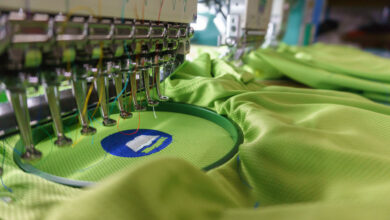If you run a garment decoration shop of any kind, you know there are pros and cons to almost any decoration technique. If you do embroidery, you’re aware that thread and needles can break, thread can bleed and dye lots can vary, and designs can stitch out poorly. Those who deal with sublimation know the pain of ghosting, too much moisture in your paper or sublimating a design upside down. People who screen print or work with rhinestones or vinyl could probably come up with similar lists. Every option for decoration has things that are great and things that are less than ideal. That includes direct-to-garment (DTG) printing.
For those who aren’t familiar, DTG printing allows decorators to print directly on the surface of the garment. It also offers the capability to print white ink. Since the capability to print white ink on dark garments was once primarily confined to screen printing, DTG was something of a revolution when it came on the scene. A printer that could print white ink, which then allowed printing designs on dark garments, could potentially be a gold mine, and for some shops it has been. The gold mine, however, comes with some caveats. Like any decoration discipline, DTG has both pros and cons.
One major pro, which can also be a con, is the capability of printing with white ink. When DTG was first introduced, white ink was the cause of great excitement and great frustration. White ink uses larger dye particles and, in the early days, often clogged printheads and caused work stoppages. As time has gone on and printer design and ink formulation have evolved, the issues that once plagued DTG have subsided somewhat.
Keep in mind that DTG printers are based on inkjet printer technology and that technology is not designed for handling white ink. So, while white ink can greatly expand the types and colors of shirts and designs that can be printed, it also brings its own set of requirements and restrictions. Working with white ink may require more patience and experimentation to find the best printer settings and atmosphere for the optimal print. DTG printing also requires pretreatment, which may mean an investment in spray guns or a pretreatment booth. Pretreatment and curing also add other steps the printing process, which must be considered when calculating production time.
You should also remember that white ink is not the only thing that makes a great graphic. White ink and printing directly on the garment can lead to amazing garments, but there are other ingredients that create the perfect shirt.
“DTG is only as good as the quality of the art. If the art file has issues, the printer will enhance them,” said Cora Komer of Opulen Artis, Inc., of Minneapolis, Minnesota.
So, when calculating your learning curve, it may be wise to add in time to learn to dial in your artwork to ensure that it will create the best DTG print possible.
One potential pro of DTG printing is that it can be a quick printing method for small-scale orders. For shops that do hundreds or thousands of shirts per order, DTG may not be the optimal method. Screen printing, because it takes time to burn screens, set up inks, and so on, may be best for bigger orders, where the time it takes to set up is worth it because the finished product will be duplicated numerous times. By contrast, DTG has a fairly quick set up and print time, so smaller orders could be turned around quickly. If you’re a smaller shop that isn’t equipped to handle huge orders, or if you’re in a market with a lot of competition from larger shops, creating a niche as the shop that can handle small orders quickly could be a big selling point.
Another major pro for DTG printing is the ability to print on dark garments. This has been the holy grail for some shops, which weren’t interested in offering screen printing but wanted to offer dark shirts and cotton shirts as well. Since DTG printing uses white ink and prints directly on the garment, it offers the ability to print colorful and elaborate designs. However, every benefit comes with a potential downside. Working with DTG will require patience. Printers will need to work with their software and printer and inks to figure out the optimal settings to get the best print.
Keep in mind that also includes dialing in the setting in which the printer is used. Things like humidity and other atmospheric conditions can have an impact on how well the machine works and the prints turn out. A shop may have to experiment with different shirt brands or shirt colors to find out which ones work best.
“Only use garments that provide a tight, smooth surface. Learn to pretreat correctly. And use quality inks,” Komer said. There may also be a learning curve with pretreatment, both learning to apply it and which types provide the best print surface. Be prepared to have patience when embarking on the DTG journey.
For those concerned with eco-friendly printing, DTG printing may be of interest. The ink used in DTG printing is water based and does not contain toxic additives. This reduces the risk of employees being exposed to harmful chemicals, and of those chemicals being introduced into the environment. DTG printing also requires less water, as there are no screens to wash. DTG printers also print better on natural fabrics, particularly cotton. That may be a selling point for customers concerned with offering eco-friendly garments. Since the printing process is mostly automated, you may find you have less waste with the DTG printer, since human error can be eliminated from the print process in a way it may not be in other printing disciplines. So, if sustainability is a concern for your shop, or your customers, DTG printing may be a solution for you.
One potential con of working with DTG printing is that you’re somewhat limited on where you can print on a garment. There’s a reason that most pictures of DTG printing show a large print on the front or the back of the shirt. Because of the design of the printers and how the shirts are loaded, it may be more difficult, or even impossible, to print on collars or cuffs. Another thing to keep in mind is that DTG printing works best on cotton, so blends or polyester may not print well or may not be an option at all. Since cotton is generally the fabric of choice for T-shirts, and T-shirt printing is probably one of the main avenues of revenue generation for DTG printers, this may not be an issue, but it is something to consider. “Some designs are not meant for DTG,” Komer said.
Price is another potential con of DTG printing. In fact, this is why Jennie Livezey of Z Shirts in Shelbyville, Indiana, decided against DTG printing. “We never got into DTG,” she said, “just because of the initial cost at the time and the amount of time required for maintenance.”
Depending on the size of the shop and the production level intended, setting up for DTG printing can get very expensive. An entry-level DTG printer will carry a cost in the neighborhood of $5,000 and $10,000. The middle of the range printers generally cost between $15,000 and $25,000 and industrial-level DTG printers can go as high as $50,000+ in cost. There is also the cost of pretreatment equipment and supplies, whether that’s simply a spray gun and pretreatment fluid or setting up a pretreatment booth. Don’t forget that you will also need a heat press or conveyor dryer for curing prints as well. All of these items add up, so DTG printing is not the cheapest option when it comes to setting up to print. Of course, the potential profits that can be made with a DTG printer may be well worth the cost.
Another potential con of DTG printing is that there is no way to test the market size before you invest in your equipment. With many decoration disciplines, you can purchase transfers and offer the decoration technique in question to your customers before actually investing in equipment. Even if you do this on a small scale, you can get some feel for what interest your customer base will have. Since DTG printing involves printing directly on the garment, there are no transfers made, and thus no way to try out the technique before investing in the equipment yourself. Granted you can — and should —do market research, check out what your potential competitors are offering, and survey your current customer base to find out their level of interest but, in the end, you’re simply going to have to leap and hope for the best.
In the end, only you can know if DTG printing is right for your business. Make sure you consider all the pros and cons before making your decision.




